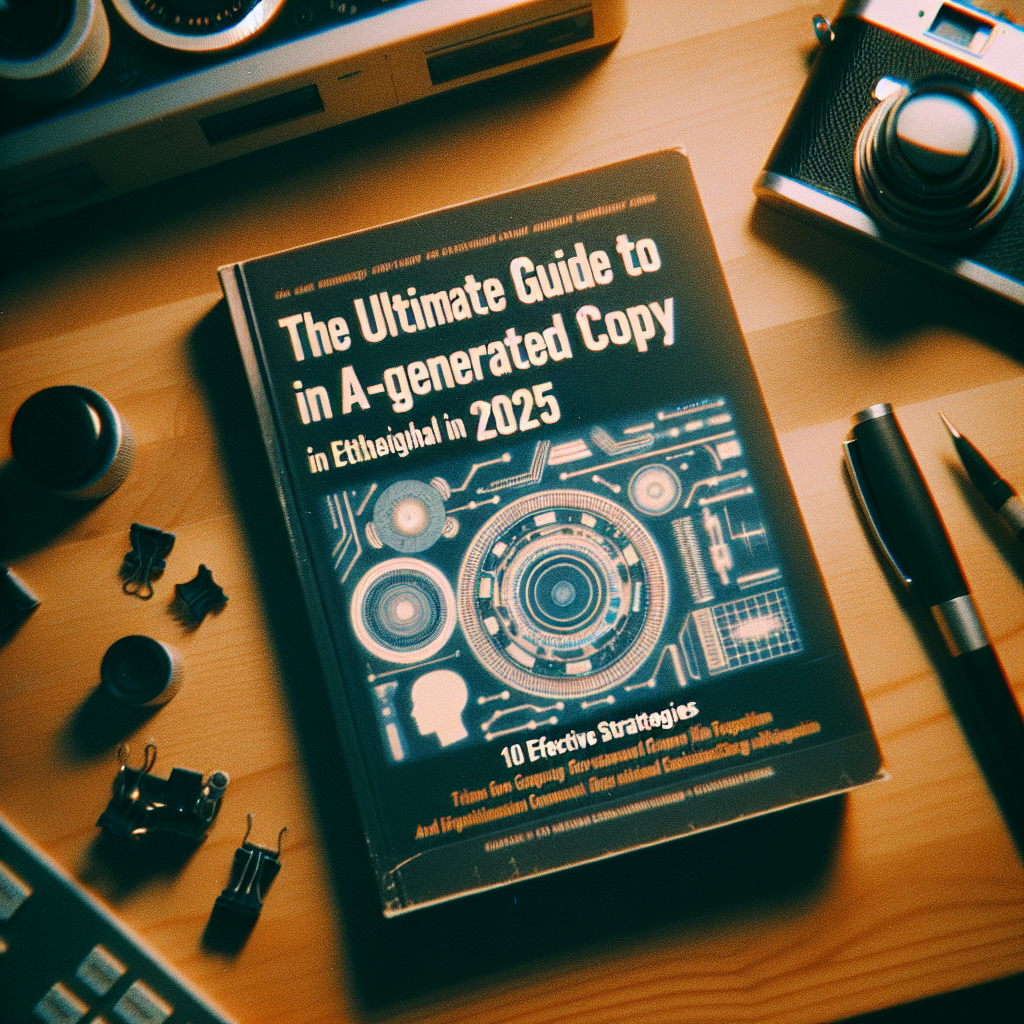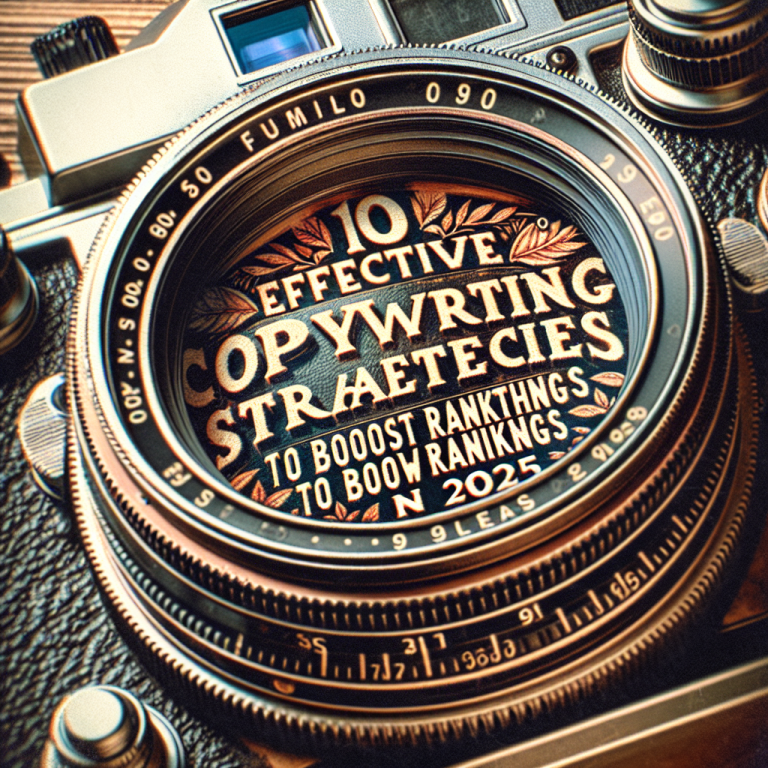The Ultimate Guide to Ethics in AI-Generated Copy in 2025: 10 Effective Strategies
Table of Contents
- 1. Clarify Intent and Promote Transparency
- 2. Implement Fairness and Bias Mitigation
- 3. Maintain Content Accuracy and Factuality
- 4. Protect User Privacy and Data Security
- 5. Promote Responsible Language and Non-Discrimination
- 6. Establish Accountability Mechanisms
- 7. Encourage Human-in-the-Loop Review
- 8. Uphold Intellectual Property and Originality
- 9. Continuous Education and Awareness
- 10. Adopt Governance and Policy Standards
Welcome to the ultimate guide on ethics in AI-generated copy for 2025. As AI technologies become increasingly integrated into marketing, content creation, and communication strategies, itâs essential to navigate the ethical considerations responsibly. Ensuring ethical practices not only protects organizations legally and reputation-wise but also builds trust with audiences. In this comprehensive article, Iâll share 10 effective strategies backed by the latest trends and best practices to help you maintain integrity in your AI-generated content this year and beyond.
1. Clarify Intent and Promote Transparency
Understanding the Purpose of AI-Generated Copy
When deploying AI for content creation, defining clear objectives is crucial. Whether your goal is marketing, informational, or entertainment, transparency about AI involvement boosts credibility. For example, a chatbot clarifying that itâs an AI assistant fosters user trust and sets realistic expectations. In 2025, consumers are increasingly aware of AI’s role, so transparency minimizes potential misunderstandings.
Additionally, companies should openly communicate how AI tools are used in content processes. For instance, a news website explaining that headlines are generated with AI helps uphold journalistic integrity. This clarity not only aligns with ethical standards but also encourages informed user interaction.
Best Practices for Promoting Transparency
- Clearly label AI-generated content in all communications.
- Provide explanations about how AI mechanisms operate, especially in sensitive areas.
- Disclose data sources and training methodologies where applicable.
Implementing transparent practices builds user trust and mitigates skepticism about AI content. To illustrate, brands like OpenAI have seen success by openly sharing their AI development processes, setting an ethical standard for others.
2. Implement Fairness and Bias Mitigation
Recognizing Bias in AI-Generated Content
AI models are trained on vast datasets, which can inadvertently encode biases. In 2025, it’s vital to constantly audit these models to identify and reduce biases related to gender, race, ethnicity, or ideology. An example is avoiding stereotypical language that could offend or misrepresent groups.
Bias mitigation involves using diverse training data and employing fairness algorithms. Regular bias assessments should be part of your content workflows, ideally involving diverse teams to spot issues that machines might miss. For example, a marketing AI that consistently produces inclusive language demonstrates this commitment effectively.
Tools and Strategies for Fair Content
- Utilize bias detection tools like IBM’s AI Fairness 360 or Google’s What-If Tool.
- Implement diverse data sets to reduce systemic bias.
- Incorporate human review, especially for sensitive topics.
Proactively addressing bias not only aligns with ethical standards but also enhances brand reputation and customer loyalty in 2025âs socially aware market.
3. Maintain Content Accuracy and Factuality
Challenges of Ensuring Truthfulness in AI Content
AI-generated copy can sometimes produce inaccurate or outdated information, risking misinformation or disinformation. As part of ethics in AI-generated copy, in 2025 itâs essential to prioritize fact-checking protocols. For example, AI tools used in healthcare must provide reliable, evidence-based information.
Implementing layered verification processes helps ensure accuracy. Combining AI outputs with human oversight minimizes errors and enhances credibility. News organizations, for example, now use AI to draft articles but rely on journalists for validation, blending efficiency with responsibility.
Best Practices for Ensuring Factual Integrity
- Regularly update AI training data with current and verified information.
- Use fact-checking tools integrated with content creation workflows.
- Train AI models to recognize and flag uncertain or potentially false statements.
Fostering a culture of accuracy protects against pitfalls for brands relying on AI-generated copy, especially as misinformation threats grow in 2025.
4. Protect User Privacy and Data Security
Data Ethics in AI Content Generation
Using user data responsibly is at the core of ethical AI practices. In 2025, strict adherence to privacy laws like GDPR and CCPA is non-negotiable. AI tools often require data collection, but transparency about data usage is essential.
For instance, when personalizing content or recommendations, companies should anonymize data and get explicit consent. This approach builds trust and avoids legal repercussions. Remember, respecting user privacy is an ongoing commitment, not a one-time compliance check.
Implementing Data Security Measures
- Encrypt sensitive data during storage and transmission.
- Regularly audit security protocols for vulnerabilities.
- Train staff on data privacy best practices.
Adopting strong data security practices safeguards your organization and aligns with ethical standards in AI-generated copy, fostering long-term trust in your brand.
5. Promote Responsible Language and Non-Discrimination
Designing Ethical Content Guidelines
In 2025, responsible language use in AI-generated copy is critical to avoid alienating or offending audiences. Developing comprehensive content guidelines that emphasize inclusive and respectful language is essential.
A practical step is integrating AI content filters that flag potentially discriminatory language. For example, AI should avoid stereotypes about age, gender, or ethnicity, ensuring the message promotes inclusion. Many companies now leverage ethical AI frameworks to embed these standards directly into their models.
Training and Sensitization
- Regular training sessions for AI developers on bias and ethics.
- Feedback mechanisms to catch language issues after deployment.
- Updating guidelines based on societal shifts and user feedback.
Responsible language promotes diversity and equality, aligning with the ethical standards for ethics in AI-generated copy in 2025.
6. Establish Accountability Mechanisms
Creating Clear Responsibility Chains
Without accountability, ethical lapses in AI-generated copy can occur undetected. In 2025, organizations should define who is responsible for AI outputs, including content creators, AI developers, and management.
This involves creating transparent reporting structures and accountability policies. For instance, if AI-generated content causes harm or spreads misinformation, there must be clear processes to address these issues swiftly.
Monitoring and Auditing AI Outputs
- Regular audits of AI-generated content for compliance with ethical standards.
- Use of third-party audits for unbiased assessments.
- Public accountability through transparency reports.
By establishing accountability mechanisms, organizations uphold responsible AI practices and reinforce the importance of ethics in AI-generated copy.
7. Encourage Human-in-the-Loop Review
The Role of Human Oversight
Even the most advanced AI tools in 2025 benefit from human oversight. Human-in-the-loop processes help catch errors, biases, or inappropriate language that AI might miss. This hybrid approach maintains high standards for ethical content.
For example, marketing teams reviewing AI-generated ad copy before publication ensure alignment with brand values and ethical standards. This collaboration creates a safety net, reducing risks associated with autonomous content creation.
Best Practices for Human-AI Collaboration
- Establish review protocols for all AI-generated content.
- Train reviewers on ethical content standards and biases.
- Utilize AI to assist human reviewers rather than replace them entirely.
This balanced approach helps preserve integrity and ensures ethics in AI-generated copy are maintained effectively in 2025.
8. Uphold Intellectual Property and Originality
Respecting Copyright Laws
AI models often generate content based on vast datasets, which raises concerns about copyright infringement. In 2025, respecting intellectual property rights is crucial for ethical AI use. Creators must ensure that generated content does not plagiarize or improperly use protected works.
Clear guidelines, combined with tools that detect similarity to existing copyrighted material, can help mitigate this risk. For example, content creators can use plagiarism checkers alongside AI tools to maintain originality.
Promoting Creativity and Innovation
- Use AI as a tool to augment human creativity rather than replace it.
- Encourage unique, brand-specific content creation.
- Implement policies that recognize and reward original ideas generated by AI-assisted workflows.
Upholding originality aligns with ethical standards and enhances reputation, especially as consumers in 2025 value authenticity.
9. Continuous Education and Awareness
Keeping Up with Ethical Best Practices
As AI evolves rapidly, continual learning about ethics in AI-generated copy is mandatory. In 2025, organizations should invest in training programs for their teams, focusing on emerging challenges, new regulations, and societal expectations.
Workshops, seminars, and certifications help keep everyone informed. For example, participating in industry forums like IEEE or IAB campaigns ensures your team stays updated on responsible AI practices.
Building an Ethical Culture
- Encourage open discussions about ethics and AI risks.
- Foster leadership commitment to ethical principles.
- Share best practices and case studies regularly.
Cultivating a culture of continuous education promotes sustainable, ethical use of AI in content generation, fostering an environment where ethics in AI-generated copy are prioritized.
10. Adopt Governance and Policy Standards
Developing Ethical AI Policies
Creating comprehensive governance frameworks for AI deployment in 2025 ensures that ethical considerations are embedded into organizational processes. Define clear standards for data use, bias mitigation, privacy, and transparency.
Public companies often publish AI ethics guidelines aligned with industry standards. These policies act as guiding documents for teams, ensuring consistent ethical behavior across all AI-generated content.
Aligning with Global Standards and Regulations
- Adopt standards like IEEEâs Ethically Aligned Design or ISO guidelines.
- Stay compliant with evolving regulations related to AI and data privacy.
- Engage with policymakers and stakeholders to shape responsible AI practices.
Implementing robust governance and policy standards creates a sustainable framework, reinforcing the importance of ethics in AI-generated copy in 2025.
Frequently Asked Questions
Q1: What are the key challenges of ethics in AI-generated copy in 2025?
Key challenges include bias and fairness, misinformation, privacy concerns, and maintaining transparency and accountability in autonomous content creation.
Q2: How can organizations ensure ethical AI practices in content generation?
By implementing clear guidelines, continuous training, human oversight, bias mitigation measures, and transparent policies, organizations can uphold responsible AI standards.
Q3: Why is transparency important for ethics in AI-generated copy?
Transparency builds trust with users, prevents misinformation, and aligns with societal expectations of responsible AI usage. It also helps clarify AI involvement and limitations.
Q4: How do you address bias in AI-generated content?
Address bias by diversifying training data, utilizing bias detection tools, conducting regular audits, and involving diverse teams in review processes.
Q5: What is the future outlook for ethics in AI-generated copy in 2025?
The future emphasizes stricter regulations, advanced bias mitigation, greater transparency, and comprehensive governance frameworksâaiming for AI that is fair, reliable, and ethically aligned.
Conclusion
As we’ve explored in this comprehensive guide, navigating ethics in AI-generated copy in 2025 requires deliberate strategies, continuous vigilance, and responsible practices. From transparency and bias mitigation to legal compliance and human oversight, each of these ten strategies helps organizations maintain integrity and foster trust. Embracing ethical principles isn’t just a regulatory necessityâit’s a strategic advantage in building authentic relationships with your audience. Moving forward, prioritizing ethics will be crucial for sustainable success in AI-driven content creation. Stay committed and proactive to ensure your AI practices uphold the highest standards of responsibility and trustworthiness.









